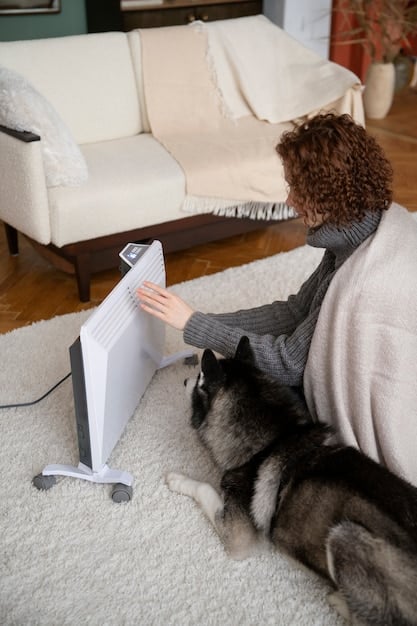Understanding Pet Allergies: Triggers and Management in 2025

Anúncios
Understanding pet allergies involves identifying triggers such as dander, saliva, and urine, and employing effective management strategies including regular cleaning, air filtration, and sometimes medication to improve the comfort and health of both pets and owners.
Pet allergies can be a significant concern for many households, impacting both human and animal well-being. Understanding pet allergies: identifying triggers and effective management strategies is crucial for creating a comfortable and healthy living environment for everyone. Let’s explore how to recognize these allergies and manage them effectively.
Anúncios
What are pet allergies and why do they occur?
Pet allergies are allergic reactions to proteins found in an animal’s skin cells, saliva, or urine. These proteins, known as allergens, can trigger an immune response in sensitive individuals. But why do some people develop these allergies?
Genetic Predisposition
Genetics plays a significant role in the development of allergies. If you come from a family with a history of allergies or asthma, you’re more likely to develop pet allergies yourself.
Anúncios
Overactive Immune System
In allergic individuals, the immune system mistakenly identifies harmless pet proteins as threats. This leads to the production of antibodies called Immunoglobulin E (IgE), which trigger the release of histamine and other chemicals, causing allergic symptoms.
- Exposure to pet allergens early in life can sometimes lead to sensitization.
- The hygiene hypothesis suggests that reduced exposure to microbes in early childhood may contribute to the development of allergies.
- Allergy symptoms can vary widely from person to person, ranging from mild to severe.
Understanding the underlying causes can help in developing effective management strategies for pet allergies. By recognizing the triggers and the body’s response, we can better control and alleviate the symptoms.

Common pet allergy triggers
Identifying the specific triggers of pet allergies is the first step toward managing them effectively. While pet dander is often the primary culprit, other substances can also cause allergic reactions. Let’s explore some common triggers.
Pet Dander
Pet dander consists of tiny, microscopic flecks of skin shed by animals with fur or feathers. These particles are easily airborne and can accumulate on furniture, bedding, and other surfaces.
Saliva and Urine
Proteins found in pet saliva and urine can also act as allergens. When pets lick themselves, these proteins are transferred to their fur, becoming airborne when the fur dries.
- Certain breeds of dogs and cats are often marketed as hypoallergenic, but no breed is entirely allergen-free.
- The size of the allergen particle can affect how easily it becomes airborne and inhaled.
- Dust mites can thrive in pet bedding, exacerbating allergy symptoms.
Identifying and minimizing exposure to these triggers is essential for reducing allergy symptoms. Regular cleaning and grooming habits can make a significant difference in managing these triggers.
Recognizing the symptoms of pet allergies
Pet allergy symptoms can vary widely, affecting different parts of the body. Recognizing these symptoms is essential for timely diagnosis and management. Here’s a rundown of common pet allergy symptoms.
Respiratory Symptoms
Respiratory symptoms are among the most common and can include sneezing, a runny or congested nose, and postnasal drip.
Skin Symptoms
Skin reactions can manifest as hives, eczema, or itchy skin. Some people may experience skin rashes after direct contact with a pet.
- Eye symptoms can include watery, red, or itchy eyes.
- Asthma symptoms may be triggered or worsened by pet allergens, leading to coughing, wheezing, and shortness of breath.
- In some cases, pet allergies can lead to chronic sinus infections.
If you suspect you have pet allergies, consult with a healthcare professional for proper diagnosis and guidance. Allergy testing can help identify specific triggers and guide treatment strategies.
Effective strategies for managing pet allergies
Managing pet allergies requires a multifaceted approach that combines environmental control, lifestyle adjustments, and medical treatments. Here are some effective strategies to help you manage pet allergies and improve your quality of life.
Environmental Control
Reducing allergen levels in your home is crucial. This can be achieved through regular cleaning, using HEPA filters, and limiting pet access to certain areas.
Lifestyle Adjustments
Making changes to your daily routine, such as washing your hands after petting animals and changing your clothes, can minimize allergen exposure.

- Antihistamines can help relieve symptoms like sneezing, itching, and runny nose.
- Decongestants can clear nasal congestion and make breathing easier.
- Nasal corticosteroids can reduce inflammation in the nasal passages.
With a combination of these strategies, many individuals with pet allergies can live comfortably with their beloved animals. It’s about finding the right balance and staying consistent with your management plan.
When to consult a healthcare professional
While many people can manage their pet allergy symptoms with over-the-counter treatments and lifestyle adjustments, there are situations where professional medical advice is necessary. Knowing when to consult a healthcare professional can ensure you receive the most appropriate and effective care.
Persistent or Severe Symptoms
If your allergy symptoms persist despite your best efforts or if they significantly impact your daily life, it’s time to seek medical help.
Asthma Complications
If you have asthma and your pet allergies are making your asthma symptoms worse, consult your doctor as soon as possible.
- Infants and young children with suspected pet allergies should be evaluated by a pediatrician or allergist.
- If over-the-counter medications are not providing relief, prescription treatments may be necessary.
- Allergy testing can help confirm the specific allergens that are causing your symptoms.
Consulting with a healthcare professional can provide clarity and a customized treatment plan to help you manage your pet allergies effectively. Don’t hesitate to seek medical advice when needed.
Future directions in pet allergy research
The field of allergy research is continually evolving, with ongoing studies exploring new ways to prevent and treat pet allergies. Here are some promising future directions in pet allergy research.
Hypoallergenic Pets
Researchers are exploring genetic modifications to create truly hypoallergenic pet breeds that produce fewer allergens.
Immunotherapy Advances
New forms of immunotherapy, such as sublingual immunotherapy (SLIT), are being developed to provide more convenient and effective allergy relief.
- Studies are investigating the role of gut microbiota in influencing the development of allergies.
- Research is focused on developing targeted therapies that block specific immune pathways involved in allergic reactions.
- Public awareness campaigns are crucial for educating people about pet allergies and promoting effective management strategies.
These ongoing research efforts offer hope for improved prevention and treatment of pet allergies in the future. Staying informed about these advances can empower you to make the best choices for managing your allergies.
| Key Point | Brief Description |
|---|---|
| 🐾 Identify Triggers | Recognize pet dander, saliva, and urine as common allergens. |
| 🏠 Environmental Control | Use HEPA filters and clean regularly to reduce allergens at home. |
| 💊 Medical Treatments | Antihistamines, decongestants, and nasal corticosteroids can help. |
| 👩⚕️ Consult a Professional | Seek advice for persistent symptoms or asthma complications. |
FAQ
▼
The most common symptoms include sneezing, runny nose, itchy eyes, skin rashes, and asthma-related issues such as coughing and wheezing. Symptoms can range from mild to severe.
▼
Regular cleaning, using HEPA filters, frequent vacuuming, and limiting pets to certain areas of the house can significantly reduce allergen levels. Also, wash pet bedding regularly.
▼
No breed is entirely allergen-free, but some breeds produce less dander. These include certain poodle mixes for dogs and Russian Blue cats. However, individual reactions can vary greatly.
▼
Common treatments include antihistamines, decongestants, nasal corticosteroids, and allergy shots (immunotherapy). Consult a healthcare professional to determine the best option for your specific needs.
▼
See a doctor if your symptoms are persistent, severe, or not relieved by over-the-counter medications. Also, consult a doctor if you have asthma and your pet allergies worsen your asthma symptoms.
Conclusion
Understanding pet allergies: identifying triggers and effective management strategies is important for maintaining a healthy and comfortable living environment. By recognizing the triggers, managing your environment, and seeking appropriate medical advice, you can effectively control your allergy symptoms and enjoy the companionship of your pets.






